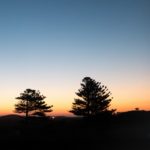(This is a continuation of “A New Season for the Barren Places.”)
During our late winter / early spring hike we saw trees! Lots of trees. Maples and Oaks, young saplings and seasoned giants. Trees growing precariously off ledges and others standing tall and straight.
Fallen trees were helping control erosion. Hollow logs provided shelter and dens for wildlife. Dead trucks and branches fallen in the creek slowed water’s rush to create new twists and turns.
In its own way, each tree promised that the new life of spring would soon replace the barrenness of winter.

Isaiah 41: 18-20 describes what God does when He brings life to barren places.
I will put in the desert the cedar and the acacia, the myrtle and the olive. I will set pines in the wasteland, the fir and the cypress together…. (19)
A Tree Study
I’ve learned a little about these trees.
Cedars, “the glory” of Lebanon, are stately and fragrant. Their durability and long branches make them valuable for construction.
The acacia tree is gnarled and thorny. That doesn’t sound attractive does it? But it produces valuable gum-arabic. The wood of the acacia was used in the ark of the covenant, the altar and even in the framework of the tabernacle. And remember that the tabernacle was the center of worship as Israel traveled through their barren places to reach the promised land.
Myrtle was used to construct sheltering “booths” for the Israelites’ during their feasts of worship. In Zechariah 1:8, angels are seen standing among myrtle trees as they speak to God, stirring Him to move on behalf of his people.
The cypress is a hard and durable tree. It’s fragrance and evergreen foliage are found growing among the tombs in the East. (Our own cemeteries often are planted with pines, relatives of the cypress.)
A dove carried an olive leaf to Noah, signifying that the flood waters were receding from the earth. The olive tree was one of the blessings God promised his people would enjoy when they reached the promised land. “Holding out the olive branch” still communicates a willingness for peace. In Revelation 11:4 the olive tree is seen in prophecy.
And the wild olive branch, grafted into the good olive tree, pictures salvation available for ALL who believe in Christ. (Romans 11:17)
Life in the Barren Places
As I reflect on the characteristics of these trees described in Isaiah 41, I cannot help but remember that when God brings life to our barren places, he brings life rich with significance and purpose.
He brings the cedar’s glory, the acacia’s usefulness, and the shelter of the myrtle. He brings the cypress’s evergreen hope to places formerly identified by death.
And he brings the wild olive branch into himself; ensuring eternal peace for the one who had been separated from him.




Leave a Reply